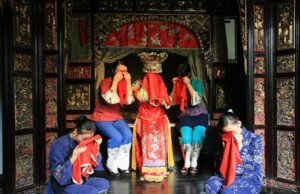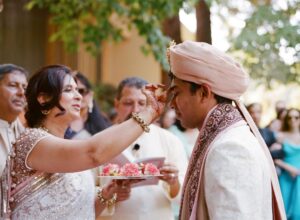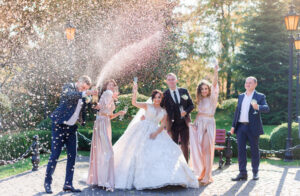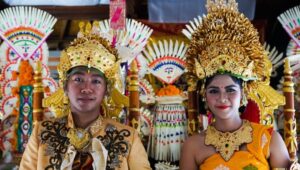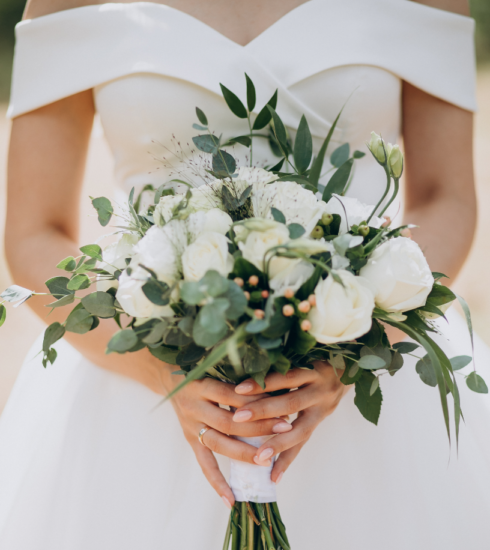Dünyanın Dört Bir Yanından Düğün Ritüelleri
Dünyamız üzerinde her toplum, kendine has kültürel ve tarihi mirasa sahip…
Bu miras, toplumların içinde yaşadığı coğrafya, farklı etnik gruplar, dini inançlar, sosyal normlar ve zaman içinde yaşanılan olaylar dizgesi tarafından şekillendiriliyor.
Gelin ve damadın dünya evine girdikleri kapı olan düğün törenleri, kültürlerin değerlerini, gelenek ve göreneklerini yansıtan çok özel etkinlikler.
Her düğünde o toplumun mitolojik örgüsüne, ahlaki bakış açılarına, kadın ve erkeğin toplum içindeki konumlanışına ait açık simgeler yer alıyor.
Hepimiz, ülkemizde gelinin beline kırmızı kurdele bağlanarak alnı öpülüp, evden dualarla çıkarılmasına, davullu zurnalı gelin almalarına, eğlenceli düğün törenlerine aşinayız. Acaba dünyanın farklı ülkelerinde düğün gelenekleri nasıl?
Gelin, birlikte kısa bir yolculuğa çıkalım…
İlk durağımız Hindistan…
Hindistan’da gelin alma ritüeli genellikle “Baraat” adı verilen renkli bir geçitle başlıyor. Damadın ailesi ve dostları, müzik eşliğinde dans ederek gelinin evine doğru ilerliyorlar.
Hindistan’da düğünler, renkli ve coşkulu törenlerle kutlanıyor. Örneğin, Haldi adı verilen bir ritüelde gelin ve damada sarımsaklı ve zerdeçallı bir karışım sürülüyor. Mehndi ritüelinde ise gelin ve yakınlarına geleneksel el ve ayak süslemeleri yapılıyor. En renkli ve dikkat çekici ritüellerden biri ise Holi Festivali’ne benzer renkli tozların kullanıldığı düğün törenleri…
Bir diğer gelenek ise, ‘Joota Chupai’ yani ayakkabı saklama ritüeli olarak adlandırılıyor… Buna göre, damat, evliliğe adım atmadan önce ayakkabılarını çıkarıyor. Gelinin ailesi ise bu ayakkabıları alıp saklamak için damadın ailesi ile tatlı bir çekişmeye giriyor.
Hindistan’da düğün günü damadı kayınvalidesi karşılıyor. Damadın ayakları yıkanıyor. Ardından bal ve süt ikramı yapılıyor.
Düğün seremonisinin son bölümünü ise ateş dansı oluşturuyor. Gelin ve damat kutsal sayılan ateş etrafında dört kez dolaşıp, hızla koşarak kendilerine ayrılan masaya oturuyorlar. Hintliler, masaya kim önce oturursa onun sözünün geçtiğine inanıyor.
Sırada Çin var…
Çin’de düğün için gelin ve damat öncelikle bir astroloji uzmanından onay almak zorunda… Adaylara ait astroloji haritaları uyumluysa düğün hazırlıklarına başlanıyor.
Çin düğünleri, köklü geleneklere dayanıyor ve birçok sembolik ritüel içeriyor. Örneğin, çiftin evlilik öncesi aşkını temsil eden “kırmızı ip” ritüelinde çiftin bileklerine kırmızı ipler bağlanıyor. “Kuai Ban” ritüeli ise damadın gelinle buluşmadan önce kapısına çiçekli bir engel koyması ve gelini seremoniyle almaya çalışması üzerine kurgulanmış.
Çin’in bir bölgesindeki adetlere göre ise gelin düğün gününden 1 ay öncesinden başlayarak her gün 1 saat ağlamak zorunda… Bu ağlama ritüeline gelinin annesi, arkadaşları ve akrabaları da katılıyor.
Ve Afrika kıtasındayız…
Afrika’da düğünler, dans, müzik ve topluluk bağlarını kutlamak için önemli ritüeller içeriyor. Bazen birkaç gün süren geleneksel dans etkinlikleri, çiftin aileleri ve köy halkının katılımıyla gerçekleşiyor. Geleneksel kıyafetler, renkli desenler ve süslemeler Afrika’da ülkeden ülkeye değişiyor.
Afrika kıtasındaki ülkelerden Kenya’nın Massai yöresinde düğün sırasında gelinin saçlarını kazıyor ve kafasına kuzu yağı sürüyorlar. Gelinin babası iyi şans getirmesi için kızın kafasına ve göğüslerine tükürüyor. Bu ritüellerden sonra, gelin kız, taş olmamak için arkasına bakmadan damadın elinden tuttuğu gibi hızla oradan uzaklaşıyor. Nijerya’da ise, gelin alma ritüeli “Knocking on the Door” olarak adlandırılıyor. Damadın ailesi, gelinin evine gelerek kapıyı çalıyor ve gelin için belirli bir miktar para ve hediyeler sunuyor. Gelin evi bunları kabul ederse, gelin ve damat düğünün yapıldığı yere gidiyorlar.
Gelelim Pakistan’daki düğün geleneklerine…
Bu ülkenin gelenekleri bize biraz garip gelebilir. Pakistan’da damat adayı sevdiği kızı almak için bir dizi sınava tabii tutuluyor. Kız ailesi, damat adayına her türlü hakareti yaparak küfür ediyor. Herkes bu esnada damadı gözlemliyor. Damat adayı bu küfürlere sakin kalarak dayanırsa ne ala… Yoksa gönül verdiği genç kızdan vazgeçmek zorunda kalıyor.
Kore, bir sonraki durağımız…
Burada eski devirlerde damatlar, beyaz bir ata biner ve arkalarında sakladıkları kazı gelin evine getirirlermiş. Günümüzde canlı kaz yerine tahta bir kazı getiriyorlar. Yine geleneklerine göre bir çift tahta ördeği çiftin evine yerleştiriyorlar.
Filipinler’deki evlilik gelenekleri daha farklı…
Kilisede yapılan düğün töreninde gelinin başına tutturulan duvağın diğer ucu damadın omzuna tutturuluyor. Böylelikle gelin ve damadın bir ömür boyu birbirlerini koruyup sağlıkla ömür sürecekleri düşünülüyor.
Şimdi sizi bir İskoç düğününe götürüyoruz…
İskoçya’da gelinin akraba ve arkadaşları yiyecekleri karıştırarak bulamaç haline getirip gelinin üzerine boşaltıyorlar. Bu da yetmezmiş gibi gelini o halde şehirde dolaştırıyorlar. Geleneğe göre amaç gelini evliliğin zorluklarına karşı hazırlayarak dayanıklı kılmakmış.
İskoçya’da düğünden önceki gece gelin büyüklerin toplandığı bir odaya gelip ortaya oturuyor. Aile büyükleri de gelinin ayaklarını bir güzel yıkıyorlar.
Düğünde damat İskoçların kilt adını verdikleri geleneksel İskoç eteğini giyerken gelinler de sırlı çiçek adını verdikleri bir broş taşıyorlar. Düğün konvoyuna yol boyunca gaydalar eşlik ediyor.
Başka bir Avrupa ülkesindeyiz; Finlandiya…
Bu ülkede gelinler, el yapımı bir altın taç takıyorlar. Düğün töreni bitince gelin kız, bu tacı bir arkadaşına veriyor. Tacı alan kız şanslı sayılıyor. Bu genç kızın kısa sürede dünya evine gireceğine kesin gözüyle bakılıyor.
Finlilerin eski düğün geleneklerinde evlilikler açık arttırma ile yapılırmış. Damat adayı gelinin babasına gelip pazarlık yapar, anlaşırlarsa kız verilirmiş. Alınan para ise kızın çeyizi olurmuş.
Sırada kapı komşumuz Bulgaristan yer alıyor…
Bulgaristan’da damat adayımız sevdiği kızı istemeye arkadaşları eşliğinde gidiyor. Bu sırada, mutluluk ve zenginlik sembolü olan rakia isimli viski ve zdravet adındaki küçük bir buketi beraberinde getiriyor. Kızın babası evlilik fikrini onayladığı anda kızına dönüp bu işi isteyip istemediğini soruyor. Gelin adayı 3 kez sorulan bu soruya evet derse, kız evi damat adayının evine hediye yolluyor ve düğün hazırlıklarına başlanıyor.
Macaristan diğer bir durağımız…
Buradaki adet oldukça garip. Düğünden önce gelini kaçırıyorlar. Yanlış okumadınız… Burada gelini kaçırmak bir gelenek… Damadın ise işi çok zor. Çünkü gelini kaçıranlarla mücadele etmek zorunda.
Şimdi de Polonya’dayız…
Bu ülkede, düğün seremonisi yapmak için özel ayları seçmeniz gerekiyor. Öyle canınızın istediği her an düğün yapamıyorsunuz. İçinde “R” harfinin geçtiği aylar olmalı mutlaka… Aksi takdirde yeni evlilerin mutlu olamayacağına inanıyorlar.
İsveç’te düğün esnasında gelinlerin işi zor.
Damadı düğünde yanlarından ayırmamak zorundalar. Yoksa gelinin vay haline… Törene gelen kadınlar damadın yanında gelini görmezlerse sarılıp öpmeye başlıyorlar. Gelenek işte… Ne diyelim…
İrlanda’nın düğün geleneği biraz masalsı…
Damat ve gelin, dans ederken çok dikkatli olmalılar. Gelin, asla ayaklarını yerden kaldırmamalı. Aksi takdirde pusuda bekleyen kötülük perilerinin gelini götüreceğine inanıyorlar.
Sıra, Alman’ların düğün geleneklerinde…
Almanya’da Anadolu’muzun bazı yörelerinde görülen bir gelenek var. Misafirler, gelin ve damadın üstüne pirinç serpiyorlar. Pirinç, bereketi simgeliyor. Gelinin saçlarına kaç tane pirinç tanesi takılırsa, çiftin o kadar çocuğu olacağına inanılıyor. Düğün seremonisinin sonunda ise, her ikisi birlikte bir kütüğü kesiyorlar. Bu da birlikte geçirecekleri yaşamın zorluklarına el birliği ile karşı koyacakları anlamına geliyor.
Ve son olarak da Endonezya’ya bakalım…
Endonezya’ya yakın küçük adalarda yaşayan Tidung kabilesi sıradışı bir geleneğe sahip.
Törenle dünya evine giren gelin ve damat artık mutludur. Muratlarına ermişlerdir. Fakat, geleneğe göre tam 3 gün evden çıkamaz ve yine bu süre boyunca tuvalete gidemezler. Ayrıca, çiftin banyo yapmaları da yasaktır. Sebebi, çiftin mutlaka bir çocuk sahibi olması gereği. Bu esnada geleneğe uyulup uyulmadığını kontrol etmek için bir akrabaları da yanlarında kalmak zorunda. Neslin devamı için uygulanan bu gelenek oldukça zorlayıcı olsa gerek.
WEDDING RITUALS FROM AROUND THE WORLD…
Every society in the world has its own cultural and historical heritage…
This heritage is shaped by the geography in which societies live, different ethnic groups, religious beliefs, social norms and the sequence of events experienced over time.
Wedding ceremonies, the entry of the bride and groom into the marriage, are very special events that reflect the values, traditions and customs of cultures.
In each wedding, there are clear symbols of the mythological structure of that society, moral perspectives, and the positioning of men and women in society.
We are all familiar with the wedding ceremonies, where the bride is tied with a red ribbon around her waist, kissed on her forehead, taken out of the house with prayers, receiving a bride with a drum and a horn. Wonder how are the wedding traditions in different countries of the world?
Let’s take a short journey together…
Our first stop is India…
The ritual of receiving a bride in India usually begins with a colorful procession called the “Baraat”. The groom’s family and friends are moving towards the bride’s house, dancing to the accompaniment of music.
Weddings in India are celebrated with colorful and enthusiastic ceremonies. For example, in a ritual called Haldi, a mixture of garlic and turmeric is rubbed on the bride and groom. In the Mehndi ritual, traditional hand and foot decorations are made for the bride and her relatives. One of the most colorful and remarkable rituals is the wedding ceremonies in which colored powders are used, similar to the Holi Festival.
Another tradition is called ‘Joota Chupai’, meaning the ritual of keeping shoes… Accordingly, the groom takes off his shoes before stepping into marriage. The bride’s family, on the other hand, enters into a sweet fight with the groom’s family to buy and keep these shoes.
In India, the mother-in-law greets the groom on the wedding day. The groom’s feet are being washed. Then honey and milk are served.
The final part of the wedding ceremony is the fire dance. The bride and groom walk around the sacred fire four times, run quickly and sit at the table reserved for them. Indians believe that whoever sits first at the table has their say.
Next up is China…
For the wedding in China, the bride and groom first have to get approval from an astrology expert… If the astrological charts of the candidates are compatible, the wedding preparations begin.
Chinese weddings are rooted in deep-rooted traditions and involve many symbolic rituals. For example, in the “red thread” ritual, which represents the couple’s premarital love, red threads are tied around the couple’s wrists. The “Kuai Ban” ritual, on the other hand, is based on the groom’s putting a flowery barrier on his door before meeting with the bride and trying to receive the bride with a ceremony.
According to the customs in a part of China, the bride has to cry for 1 hour every day, starting one month before the wedding day… The bride’s mother, friends and relatives also participate in this crying ritual.
And we are on the African continent…
Weddings in Africa include dance, music, and important rituals to celebrate community bonds. Sometimes the traditional dance events, which last for several days, take place with the participation of the couple’s families and the villagers. Traditional clothes, colorful patterns and decorations vary from country to country in Africa.
In the Massai region of Kenya, one of the countries on the African continent, they shave the bride’s hair and apply lamb fat on her head during the wedding. The bride’s father spits on the girl’s head and breasts for good luck. After these rituals, the bride-to-be takes the groom’s hand and walks away quickly, without looking back, so as not to become a stone. In Nigeria, the wedding ceremony is called “Knocking on the Door”. The groom’s family comes to the bride’s house and knocks on the door and offers a certain amount of money and gifts for the bride. If the bride’s house accepts these, the bride and groom go to the wedding venue.
Let’s come to the wedding traditions in Pakistan…
The traditions of this country may seem a little strange to us. In Pakistan, the groom-to-be is subjected to a series of tests to get the girl he loves. The girl’s family is cursing the groom-to-be by making all kinds of insults. Everyone is observing the groom during this time. The groom-to-be has to endure these curses by staying calm. Otherwise, he has to give up on the girl he loves.
Korea, our next stop…
Here in ancient times, the grooms used to ride a white horse and bring the goose they hid behind them to the bride’s house. Nowadays they bring a wooden goose instead of a live goose. Again, according to their tradition, they place a pair of wooden ducks in the couple’s house.
Marriage traditions in the Philippines are different…
In the wedding ceremony held in the church, the other end of the veil, which is attached to the bride’s head, is attached to the groom’s shoulder. In this way, it is thought that the bride and groom will protect each other for a lifetime and live a healthy life.
Now we take you to a Scottish wedding…
In Scotland, the bride’s relatives and friends mix the food into a slurry and pour it on the bride. As if that weren’t enough, they are walking the bride around the city like that. According to tradition, the aim was to prepare the bride for the difficulties of marriage and make her durable.
In Scotland, the night before the wedding, the bride comes to a room where the elders gather and sits in the middle. Family elders also wash the bride’s feet well.
At the wedding, the groom wears the traditional Scottish skirt called kilt, while the brides wear a brooch called a glazed flower. Bagpipes accompany the wedding convoy along the way.
We are in another European country; Finland…
In this country, brides wear a handmade gold crown. When the wedding ceremony is over, the bride gives this crown to a friend. The girl who gets the crown is considered lucky. It is certain that this young girl will enter the world marriage in a short time.
In the ancient Finnish wedding tradition, marriages were made by auction. The groom-to-be would come to the bride’s father and negotiate, and if they agreed, the girl would be given. The money received was the dowry of the girl.
Our next-door neighbor Bulgaria is next…
In Bulgaria, our groom-to-be goes to ask for the girl he loves, accompanied by his friends. Meanwhile, she brings along a whiskey called rakia, a symbol of happiness and wealth, and small bouquet called zdravet. As soon as the girl’s father approves of the idea of marriage, he turns to his daughter and asks if she wants the job. If the bride-to-be says yes to this question, which is asked 3 times, the bride’s house sends a gift to the groom’s house and the wedding preparations begin.
Hungary is another stop…
The custom here is pretty weird. They kidnap the bride before the wedding. You read it right… It’s a tradition to kidnap the bride here… The groom’s job is very difficult. Because he has to fight with those who kidnapped the bride.
Now we are in Poland…
In this country, you have to choose special months to have a wedding ceremony. You can’t have a wedding any time you want. There must be months with the letter “R” in them. Otherwise, they believe that the newlyweds will not be happy.
Brides have a tough job during a wedding in Sweden.
They have to keep the groom with them at the wedding. Otherwise, woe to the bride… If the women who come to the ceremony do not see the bride next to the groom, they start to hug and kiss. It’s tradition… What shall we say…
Ireland’s wedding tradition is a bit of a fairy tale…
Groom and bride must be very careful while dancing. The bride should never lift her feet off the ground. Otherwise, they believe that the evil fairies waiting in ambush will take the bride away.
Next is the wedding traditions of the Germans…
In Germany, there is a tradition seen in some parts of Anatolia. The guests sprinkle rice on the bride and groom. Rice symbolizes fertility. It is believed that the more rice grains attached to the bride’s hair, the more children the couple will have. At the end of the wedding ceremony, they both cut a log together. This means that they will face the difficulties of the life they will spend together.
And finally, let’s look at Indonesia…
The Tidung tribe, which lives on small islands close to Indonesia, has an unusual tradition.
The bride and groom, who entered the marriage with a ceremony, are now happy. They have reached their Murat. However, according to tradition, they cannot leave the house for 3 days and they cannot go to the toilet during this time. Also, the couple is not allowed to take a bath. The reason is that the couple must have a child. In the meantime, a relative has to stay with them to check whether the tradition is followed. This tradition, which is applied for the continuation of the generation, must be quite challenging.




